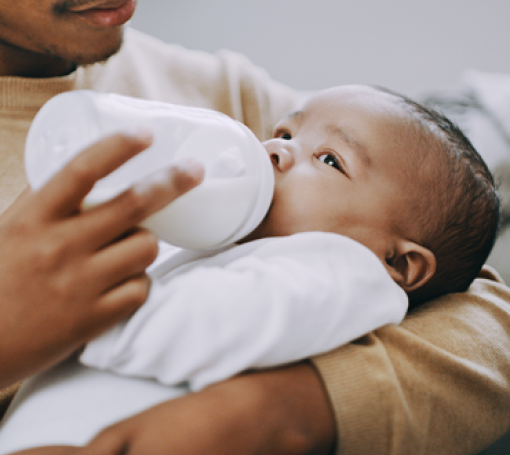
What is a fever?
A fever is the body’s natural way of fighting an illness or infection. A temperature of 100.4° F (38° C) or higher is considered a fever. Fevers are common in children. Most fevers in children accompany a mild illness and will go away on their own with treatment at home. However, there are times when a fever needs to be evaluated by your child’s medical team.
What is the best way to take my child’s temperature?
Your child’s temperature may be taken with a digital thermometer in a number of ways. The best way to take it depends on the age of the child. We recommend using a rectal thermometer for infants 0-3 months of age. Temporal (forehead) thermometers are reliable for children 3 months and older. View our Taking a Temperature guide for more information.
What can I do to help reduce my child’s fever?
Dehydration can occur with fever, so it is important to keep your child hydrated. If your child is uncomfortable, you may use medication to treat their fever such as acetaminophen (Tylenol), in children of any age, or ibuprofen (Motrin or Advil), in children over 6 months old. You should NOT give your child aspirin to treat a fever or illness unless you are specifically instructed to do so by their medical team. If you have treated your child’s temperature with acetaminophen or ibuprofen and continue to see fast breathing, lethargy, or significant fussiness, please call their medical team.
Limiting exposure to other children and adults is important while your child is sick. Please keep your child home until they are fever-free for at least 24 hours, without taking a fever-reducing medication.
When should I seek medical care for my child’s fever?
While many fevers are a natural response to an infection, there are times you should seek medical attention for your child.
Please bring your child in for an exam if they have any level of fever and any one of the following:
- Child is ill-appearing, lethargic, inconsolable, or in distress
- Fever occurs in an infant 0-3 months of age
- Fever lasts longer than 3 days
- There are no other symptoms besides fever and fever lasts more than 24 hours
- Fever is related to environment, such as running in extreme heat or staying in a hot car too long
- Fever reaches 105° F (40.6° C) or causes hallucinations
- Fever goes away for 24 hours or more then returns
- Any time a parent has concerns
Myths vs Facts:
MYTH: Fevers are harmful to children.
FACT: A fever is the body’s natural way of fighting an illness or infection. Illness from viruses and bacteria can both cause fevers. Fevers between 100-104° F (37.8-40° C) allow the body to do what it is supposed to do to help sick children get better.
MYTH: A temperature between 98.7-100° F (37.1-37.8° C) is considered a low-grade fever.
FACT: A temperature of 100.4F (38C) is considered a fever. Temperatures between 100.4-102° F (38-39° C) are called low-grade fevers. High fevers are 104° F (40° C) and above. It is normal for temperature to fluctuate between 97-100° F (36.1-37.8° C) based on physical activity and environmental factors.
MYTH: If my child feels warm, they have a fever.
FACT: If your child feels warm but does not have any symptoms of illness, they probably do not have a fever. Certain activities and environmental factors such as playing hard, intense crying, getting out of a warm bed, or being in hot weather can impact how their skin feels. If your child feels warm and has symptoms of illness, they probably have a fever. View our Taking a Temperature guide for tips on how to take an accurate temperature.
MYTH: Fevers are painful for children.
FACT: Most fevers below 105° F (40.6° C) do not cause discomfort. Your child may be uncomfortable due symptoms of the illness causing the fever, such as a sore throat.
MYTH: High fevers are caused by serious illnesses.
FACT: A high fever does not mean the illness causing the fever is severe. Many illnesses such as influenza, COVID, and RSV can cause high fevers in children.
MYTH: Fevers above 104° F (40° C) can cause brain damage or seizures.
FACT: Most fevers from infections stay below 104° F (40° C). This is because the brain regulates the body’s temperature, keeping it at the right temperature to fight infection. Seizures from high fevers are very rare, occurring in less than 4% of children. Seizures associated with fevers do not cause permanent damage. Brain damage from a fever is also extremely rare and only occurs when the body’s temperature goes above 108° F (42.2° C). Fevers this high only occur because of human error, such as leaving a child in a hot car. Contact your child’s Primary Care Provider (PCP) if their fever reaches 105° F (40.6° C) or causes hallucinations.
MYTH: All fevers should be treated with medication.
FACT: Most kids do not need fever to be treated unless 102° F (38.9° C) and above. Remember that fevers help your child’s body fight infection and only treat them if your child is uncomfortable. Always look at your child and treat the child and not the temperature.
MYTH: Fever reducing medication will eliminate a fever.
FACT: Fever reducing medications will bring the fever down 1-2° F temporarily. Your child’s fever may rise again after the fever reducing medication has worn off. Expect most fevers to last for 2-3 days while the body fights an infection. Contact your child’s PCP if their fever lasts longer than 3 days.
MYTH: Giving children multiple fever reducing medications will help fight the fever faster.
FACT: Do not use multiple fever reducing medications. If you decide to give your child fever reducing medication, choose either acetaminophen (Tylenol) or ibuprofen (Advil or Motrin), in the correct dosage. Ibuprofen can irritate stomachs so is better to give with food and is processed through the kidneys so should never be given if your child is dehydrated.
MYTH: Treating a fever will allow the infection causing the fever to go away faster.
FACT: Giving your child fever reducing medication will not make your child’s underlying illness go away any faster. The body takes time to fight off infections and illness. Most fevers that occur with an infection last for 2-3 days and symptoms from infection, such as cough and congestion, may last 10+ days, regardless of using fever reducing medication.
Keep Reading
View All Posts
What to Know About Infant Formula
Choosing the right baby formula is important, and we’re here to help you understand the facts and keep your baby safe.

Baby's First Milestones
Watching your baby grow and change in the first year is exciting and sometimes overwhelming. Learn about key physical, social/emotional, and speech milestones to help you understand your baby’s development.

Positive Parenting Techniques
Positive parenting focuses on building a nurturing relationship to teach children important life skills like problem-solving, emotional regulation, and communication.

